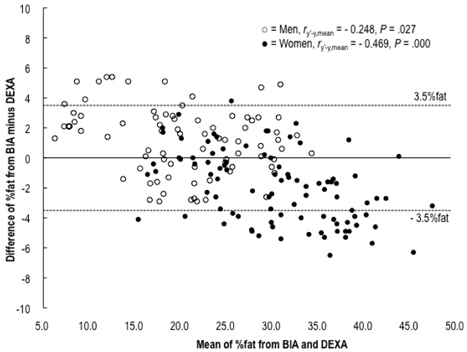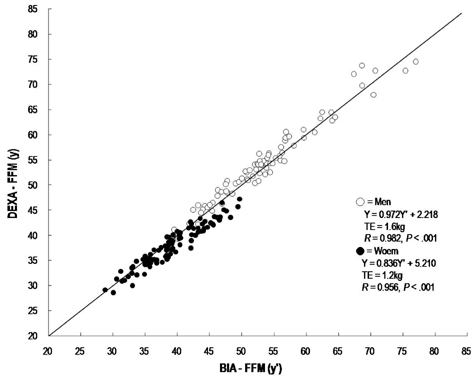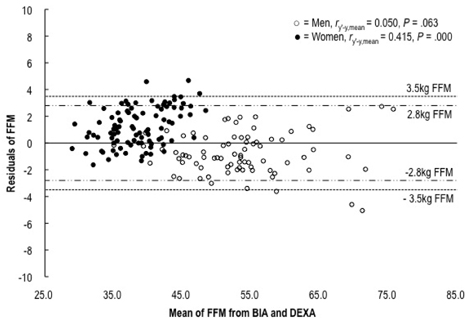Nutr Res Pract.
2011 Jun;5(3):246-252.
External cross-validation of bioelectrical impedance analysis for the assessment of body composition in Korean adults
- Affiliations
-
- 1Measurement and evaluation in sports science, Soonchunhyang University, Chungman 336-745, Korea.
- 2Department of Physiology and Biophysics, Antiaging Research Center, School of Medicine, Eulji University, 143-5, Yogdu-dong, Chung-gu, Daejeon 301-832, Korea. ckim@eulji.ac.kr
- 3Department of Anesthesiology and Pain Medicine, College of Medicine, Hanyang University, Seoul 133-792, Korea.
- 4Department of Preventive Medicine, School of Medicine, Eulji University, Daejeon 301-832, Korea.
- 5Department of Family Medicine, Asan Medical Center, Seoul 138-736, Korea.
- 6Department of Pediatrics, Konkuk University Medical Center, School of Medicine, Konkuk University, Seoul 143-729, Korea.
Abstract
- Bioelectrical impedance analysis (BIA) models must be validated against a reference method in a representative population sample before they can be accepted as accurate and applicable. The purpose of this study was to compare the eight-electrode BIA method with DEXA as a reference method in the assessment of body composition in Korean adults and to investigate the predictive accuracy and applicability of the eight-electrode BIA model. A total of 174 apparently healthy adults participated. The study was designed as a cross-sectional study. FM, %fat, and FFM were estimated by an eight-electrode BIA model and were measured by DEXA. Correlations between BIA_%fat and DEXA_%fat were 0.956 for men and 0.960 for women with a total error of 2.1%fat in men and 2.3%fat in women. The mean difference between BIA_%fat and DEXA_%fat was small but significant (P < 0.05), which resulted in an overestimation of 1.2 +/- 2.2%fat (95% CI: -3.2-6.2%fat) in men and an underestimation of -2.0 +/- 2.4%fat (95% CI: -2.3-7.1%fat) in women. In the Bland-Altman analysis, the %fat of 86.3% of men was accurately estimated and the %fat of 66.0% of women was accurately estimated to within 3.5%fat. The BIA had good agreement for prediction of %fat in Korean adults. However, the eight-electrode BIA had small, but systemic, errors of %fat in the predictive accuracy for individual estimation. The total errors led to an overestimation of %fat in lean men and an underestimation of %fat in obese women.
Keyword
Figure
Reference
-
1. Wells JCK. Body composition in childhood: effects of normal growth and disease. Proc Nutr Soc. 2003. 62:521–528.
Article2. Bigaard J, Frederiksen K, Tjønneland A, Thomsen BL, Overvad K, Heitmann BL, Sørensen TI. Body fat and fat-free mass and all-cause mortality. Obes Res. 2004. 12:1042–1049.
Article3. Janssen I, Heymsfield SB, Ross R. Low relative skeletal muscle mass (sarcopenia) in older persons is associated with functional impairment and physical disability. J Am Geriatr Soc. 2002. 50:889–896.
Article4. Kopelman PG. Obesity as a medical problem. Nature. 2000. 404:635–643.
Article5. James PT. Obesity: The worldwide epidemic. Clin Dermatol. 2004. 22:276–280.
Article6. James PT, Rigby N, Leach R. International Obesity Task Force. The obesity epidemic, metabolic syndrome and future prevention strategies. Eur J Cardiovasc Prev Rehabil. 2004. 11:3–8.
Article7. Seidell JC, Kahn HS, Williamson DF, Lissner L, Valdez R. Report from a Center for Disease Control and Prevention Workshop on use of adult anthropometry for public health and primary health care. Am J Clin Nutr. 2001. 73:123–126.
Article8. WHO Expert Consultation. Appropriate body-mass index for Asian population and its implications for policy and intervention strategies. Lancet. 2004. 363:157–163.9. Heyward VH, Wagner DR. Heyward VH, Wagner DR, editors. Skinfold methods and additional anthropometric methods. Applied Body Composition Assessment. 2004. Champaign, IL: Human Kinetics;49–85.10. Sun SS, Chumlea WC, Heymsfield SB, Lukaski HC, Schoeller D, Friedl K, Kuczmarski RJ, Flegal KM, Johnson CL, Hubbard VS. Development of bioelectrical impedance analysis prediction equations for body composition with the use of a multicomponent model for use in epidemiologic surveys. Am J Clin Nutr. 2003. 77:331–340.
Article11. Houtkooper LB, Lohman TG, Going SB, Howell WH. Why bioelectrical impedance analysis should be used for estimating adiposity. Am J Clin Nutr. 1996. 64:3 Suppl. 436S–448S.
Article12. Kushner RF, Kunigk A, Alspaugh M, Andronis PT, Leitch CA, Schoeller DA. Validation of bioelectrical-impedance analysis as a measurement of change in body composition in obesity. Am J Clin Nutr. 1990. 52:219–223.
Article13. Kyle UG, Genton L, Lukaski HC, Dupertuis YM, Slosman DO, Hans D, Pichard C. Comparison of fat-free mass and body fat in Swiss and American adults. Nutrition. 2005. 21:161–169.
Article14. Chumlea WC, Guo SS, Kuczmarski RJ, Flegal KM, Johnson CL, Heymsfield SB, Lukaski HC, Friedl K, Hubbard VS. Body composition estimates from NHANES III bioelectrical impedance data. Int J Obes Relat Metab Disord. 2002. 26:1596–1609.
Article15. Schutz Y, Kyle UUG, Pichard C. Fat-free mass index and fat mass index percentiles in Caucasians aged 18-98y. Int J Obes Relat Metab Disord. 2002. 26:953–960.
Article16. Jakicic JM, Wing RR, Lang W. Bioelectrical impedance analysis to assess body composition in obese adult women: the effect of ethnicity. Int J Obes Relat Metab Disord. 1998. 22:243–249.
Article17. Ward LC, Heitmann BL, Craig P, Stroud D, Azinge EC, Jebb S, Cornish BH, Swinburn B, O'Dea K, Rowley K, McDermott R, Thomas BJ, Leonard D. Associatin between ethnicity, body mass index, and bioelectrical impedance. Implications for the population specificity of prediction equations. Ann N Y Acad Sci. 2000. 904:199–202.
Article18. Heyward VH, Wagner DR. Heyward VH, Wagner DR, editors. Bioelectrical impedance analysis. Applied Body Composition Assessment. 2004. Champaign, IL: Human Kinetics;87–98.19. Dioum A, Gartner A, Cisse AS, Delpeuch F, Maire B, Wade S. Validity of impedance-based equations for the prediction of total body water as measured by deuterium dilution in African women. Am J Clin Nutr. 2005. 81:597–604.
Article20. Korea National Statistical Office. Healthcare and welfare. Explore Korea through statistics. 2004. Seoul: Korea National Statistical Office;85–92.21. Kim DM, Ahn CW, Nam SY. Prevalence of obesity in Korea. Obes Rev. 2005. 6:117–121.
Article22. Heyward VH, Wagner DR. Heyward VH, Wagner DR, editors. Sources for body composition equipment. Applied Body Composition Assessment. 2004. Champaign, IL: Human Kinetics;221–224.23. Patents & Certification. Biospace Co [Internet]. Available from: http://www.biospace.co.kr.24. Kyle UG, Bosaeus I, De Lorenzo AD, Deurenberg P, Elia M, Gómez JM, Heitmann BL, Kent-Smith L, Melchior JC, Pirlich M, Scharfetter H, Schols AM, Pichard C. Composition of the ESPEN Working Group. Bioelectrical impedance analysis--part I: review of principles and methods. Clin Nutr. 2004. 23:1226–1243.
Article25. Medici G, Mussi C, Fantuzzi AL, Malavolit M, Albertazzi A, Bedogni G. Accuracy of eight-polar bioelectrical impedance analysis for the assessment of total and appendicular body composition in peritoneal dialysis patients. Eur J Clin Nutr. 2005. 59:932–937.
Article26. Sluyter JD, Schaaf D, Scragg RKR, Plank LD. Prediction of fatness by standing 8-eletrode bioimpedance: a multiethnic adolescent population. Obesity (Silver Spring). 2010. 18:183–189.
Article27. Wang Z, Pierson RN Jr. Total body cabon and oxgen masses: evaluation of dual-energy x-ray absorptiometry estimation by in vivo neurton activation analysis. Phys Med Biol. 2010. 55:5953–5963.
Article28. Wang Z, Heymsfield SB, Chen Z, Zhu S, Pierson RN. Estimation of percentage body fat by dual-energy x-ray absorptiometry: evaluation by in vivo human elemental composition. Phys Med Biol. 2010. 55:2619–2635.
Article29. Lohman TG. Advances in Body Composition Assessement. 1992. Champaign, IL: Human Kinetics;3–4.30. Lee HJ, Kim HC, Vitek L, Nam CM. Algae comsumption an risk of type 2 diabetes: Korean National Health and Nutrition Examination Survey in 2005. J Nutr Sci Vitaminol (Tokyo). 2010. 56:13–28.31. Haderslev KV, Haderslev PH, Staun M. Accuracy of body composition measurements by dual energy x-ray absorptiometry in underweight patients with chronic intestinal disease and in lean subjects. Dyn Med. 2005. 4:1.32. Tothill P, Avenell A, Love J, Reid DM. Comparisons between Hologic, Lunar, and Norland dual-energy X-ray absorptionmeters and other techniques used for whole-body soft tissue measurements. Eur J Clin Nutr. 1994. 48:781–794.33. Stolarczyk LM, Heyward VH, Van Loan MD, Hicks VL, Wilson WL, Reano LM. The fatness-specific bioelectrical impedance analysis equations of Segal et al: are they generalizable and practical? Am J Clin Nutr. 1997. 66:8–17.
Article34. Rush EC, Chandu V, Plank LD. Prediction of fat-free mass by bioimpedance analysis in migrant Asian Indian men and women: a cross validation study. Int J Obes (Lond). 2006. 30:1125–1131.
Article35. Valencia ME, Alemán-Mateo H, Salazar G, Hernández Triana MH. Body composition by hydrometry (deuterium oxidedilution) and bioelectrical impedance in subjects aged > 60y from rural regions of Cuba, Chile and Mexico. Int J Obes Relat Metab Disord. 2003. 27:848–855.
Article
- Full Text Links
- Actions
-
Cited
- CITED
-
- Close
- Share
- Similar articles
-
- Body Composition by Bioelectrical Impedance Analysis in Obese Children
- Validity of Bioelectrical Impedance Analysis (BIA) in Measurement of Human Body Composition
- Utility of Bioelectrical Impedance Analysis for Body Composition Assessment
- Various Methods of Analysing Body Composition
- Changes in Body Composition after a Radical Gastrectomy for a Gastric Adenocarcinoma using Bioelectrical Impedance Analysis during the First Year following Surgery






